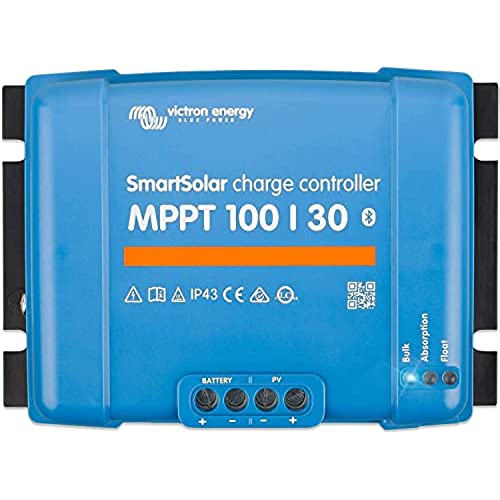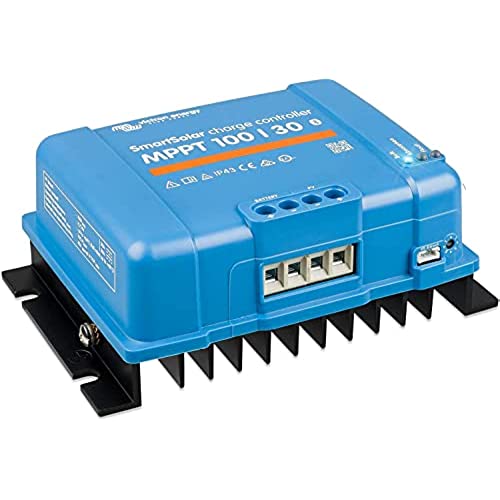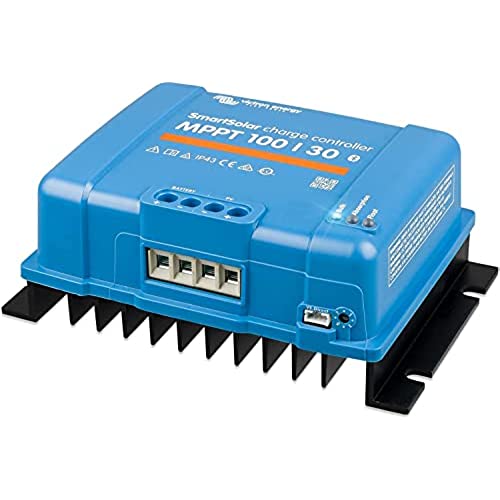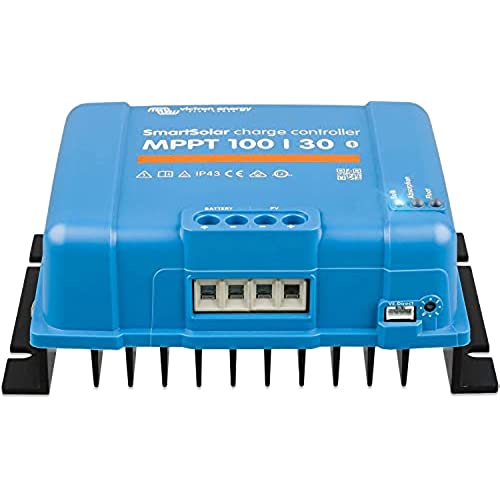









Victron Energy SmartSolar MPPT 100V 30 amp 12/24-Volt Solar Charge Controller (Bluetooth)
-

david heinrich
Greater than one weekThis little solar charger is packed with Bluetooth built in, the range is somewhat limited but Ive NO issue with that. The electrical ports could use better little screws for lack of knowing the right name for it. Or better idea, package in some wire leads that fit it well. For the size of charger I got(75/15) the sizing is great. Very solid housing, with corner holes for mounting.
-

Tyson Moore
Greater than one weekThe Victron 100 20 MPPT controller delivers peformance as effortlessly and efficiently as it delivers energy. This unit was connected to two 105 A-hr lead acid deep cycle batteries for storage, two 120 W Photovoltaic panels for energy capture, powering a load composed of a Dometic 95DZ dual zone fridge freezer. For the test a grocery load was simulated with two 1 gallon jugs of tap water and two ice cube trays of water to make ice. The test was begun late in afternoon on Saturday and concluded early evening on Sunday. The Victron supplied energy throughout the entire process and smoothley and effortlessly transitioned from solar power to battery. As the sun came up I was able to monitor panel voltage in real time, and began to see it slowly offset battery power, until the batteries began to charge and all power for the Dometic was supplied by panels. The test was a complete success and demonstrated to me the need to expand the system by one battery and one pannel to 345 A-hr, and 360 W solar. The Victron did extremely well and was only slightly warm at highest load condition. Thank you!
-

REB
> 3 dayExcellent quality construction is evident. I found it very easy to set up and operate the app. I can sit in my RV and get good bluetooth reception from the unit which is located outside near the fron of my RV. It pulls in power and sends it to my lithium battery even during overcast.
-

J. Torres
Greater than one weekI do love this unit, but I have a major problem with the business model. Victron sells a battery monitor for hundreds of dollars that you have to buy to track the state of your battery (unless a voltage reading is enough for you). But there is absolutely no reason why the functionality of the battery monitor could not be written into the firmware of the MPPT if you are using a single MPPT to charge your battery and have no loads connected directly to the battery. The MPPT is already tracking current in and out of the battery and is, in fact, the device controlling that flow. You can read the instantaneous values in the app. But they decide not to go one tiny step further and allow you figure out the Ah left in your battery by tracking these values over time. This is very frustrating because the battery monitor costs more than the MPPT, yet the MPPT is already physically capable of monitoring the battery. I have enjoyed using the product, but will steer away from Victron as soon as a decent alternative pops up because of the business model. EDIT: the single reason I wouldn’t buy this again is because the screw terminals are so frustrating to use. I can’t understand why they would go cheap on such a simple component. I had to buy a special screw driver to access (electricians screwdriver with narrow, deep shaft). And even with the right screwdriver, I often struggle to get it the bite down unless i can get in and visualize the mechanism. It only effectively bites stranded wire, almost impossible to use solid copper.
-

Douglas L. Tooley
> 3 dayThis is my second one of these. The Bluetooth based information from the unit raised my solar expertise up a level. Do make sure to change the Bluetooth pin as this is an internet of things device. Voltage does change curiously, but that’s the built in temperature adjustment. The load circuit does get tripped occasionally, I presume from some of the cheaper power outlets I used. It isn’t clear how to reset when this happens, I just disconnect the positive load and connect it directly to the battery, then switch back after a awhile. I’ve had that happen 2-3 times a year on my first unit and it is still working good. This is a lead acid designed controller but is fully programmable and includes agm and lithium presets.
-

J. Hettinger
> 3 dayThe SmartSolar MPPT 100/50 Charge Controller Bluetooth worked initially, but it suddenly will not work. My other Victron Bluetooth products have worked for a long time, several years. This did not. It was a good charge controller for a few months, but now I have no control over it. I went through all the troubleshooting guides, and performed everything they suggested, but still will not work. I am considering either getting the optional display or the Bluetooth Dongle, but it is not necessary for Smart Solar products, and if the cost for the two are 25% what a new solar MPPT charge controller from a competitor costs, I will probably just change it out for a different brand. Too bad - all my other Victron products in the system work well. The Bluetooth on other components work fine. Since I cannot connect to Blue tooth, I cannot even update the firmware to see if that works. There is really no real tech support that I can find.
-

MacGyver Jr.
> 3 dayUsing this to charge up a battery bank. The bluetooth connectivity range is a little on the weak side. I have had to exchange this unit several times for that fact, however, as a charge controller it performs very well. There are a lot of cool logging features and it is very customizable to your specific battery chemistry. The unit does run a little warm when panels are at peak production, but quite impressive being one of the few units that is this compact and doesnt rely on a very loud fan for cooling.
-

Cozy Living Machine
> 3 dayI love the Victron SmartSolar charge controller. Weve had 2 of these and just ordered a 150|100 unit for our 1200W expansion on our new RV. These are simple, operate via bluetooth so I dont have to cut any holes and mount a monitor anywhere. It would be cool if I could see the stats via wi-fi, but honestly I dont care to pay for that feature, and bluetooth is more than enough. Its easy to mount, the app is stupid-proof to set up and use, and my only complaint would be that the wires get a little too close to each other for my own comfort while wiring them up. Otherwise, this is the top of the line for charge controllers, and youll certainly pay for it. Just cry, get it over with, and enjoy your purchase.
-

Idell Jaskolski II
> 3 dayCharge controller did not work properly from the beginning. Ultimately ended up with error code 28 repeatedly and controller was dead. I returned it and the replacement is working correctly so far.
-

Tim Erskine
> 3 day12V Solar Generator project up and running with this Victron 100/30 MPPT Solar Charge Controller. This item was a little pricey but you get what you pay for. Good investment for my project. Range on bluetooth is limited but app works great when in range.
